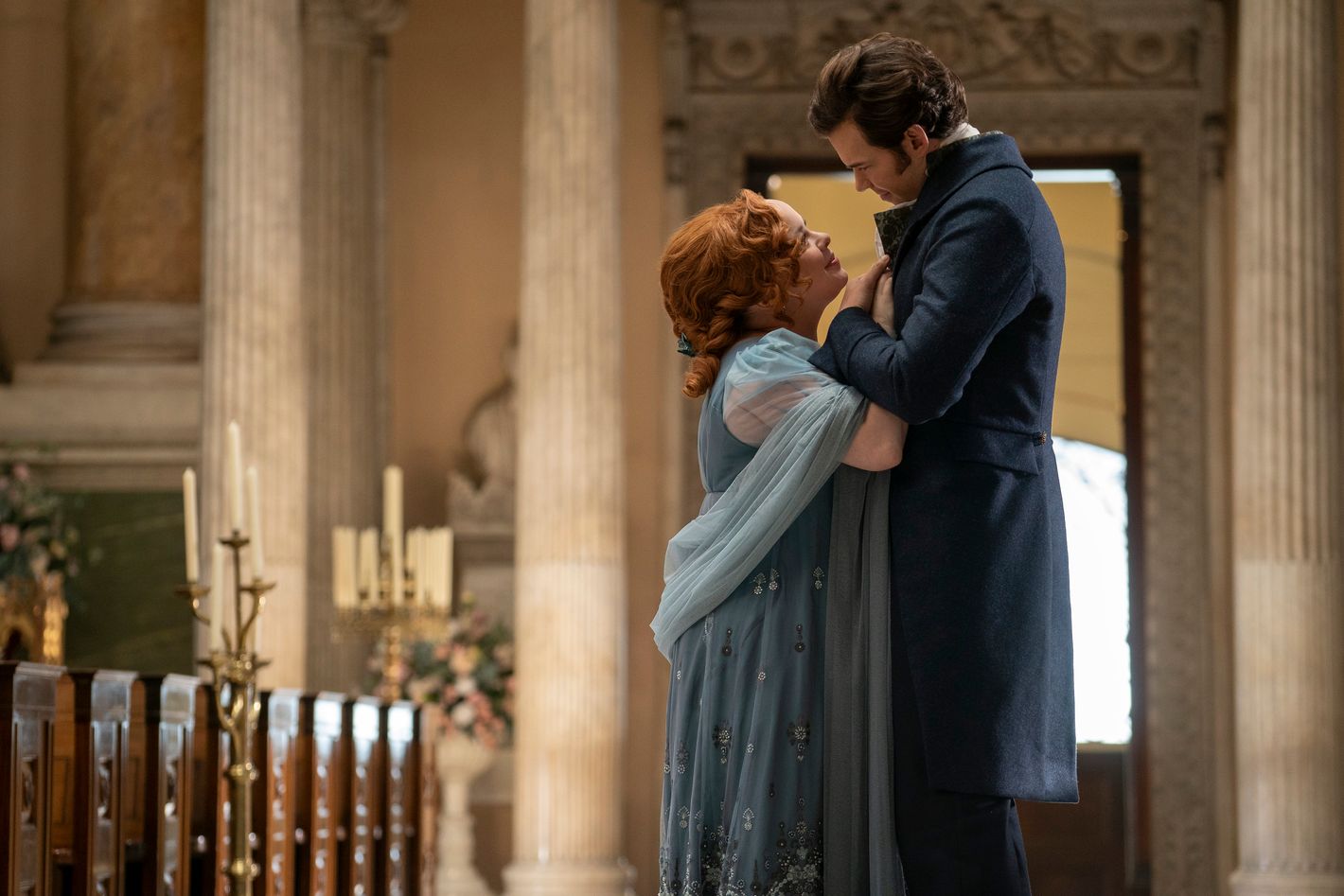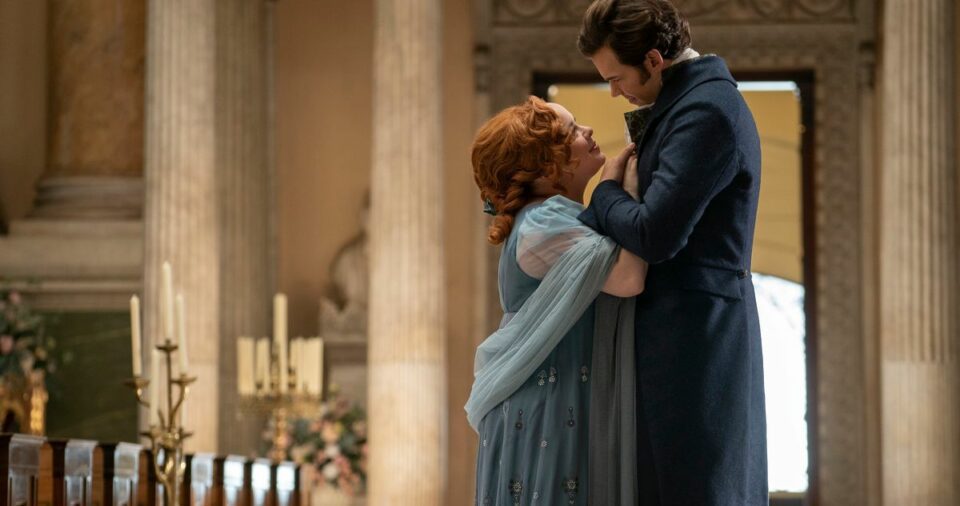[ad_1]

When you watch Bridgerton, you may notice the titular siblings love to stare. Daphne’s eyes linger on Simon Basset’s mouth as he swirls a spoon on his tongue. Anthony stares so intently at Kate Sharma that you think he’ll burn a hole through her. The third season’s relationship between Colin and Penelope Featherington hasn’t slowed this intensity; in the words of the show’s audio-description author Liz Gutman, “Colin stares as she dips an icing-flecked finger into her mouth and licks her plump pink lips. His mouth hangs agape.” Surely your mouth also hangs agape reading this.
For the blind and low-vision community, these audio descriptions aptly and entertainingly describe all those stolen glances and gazes, as well as the costumes and surroundings that make up the delight and romance of Bridgerton. Netflix’s accessibility efforts have noticeably expanded over the past few years, learning from Squid Games’s dubbing challenges and Stranger Things’s very memed captioning to offer not only an essential service but add new color to its original series.
For this season of Bridgerton, it’s the audio description, or AD, that has fans talking. The series’ spiciest scenes have a descriptive oomf, as if they’re ripped straight from a romance novel. The flow of Gutman’s prose as well as the services of voice actor Stuart Williams were part of what Netflix director of dubbing global Catherine Retat told me is “a bolder move” for Netflix. “We’re finding voices and personalities that match the content,” she said. Currently, audio description for Bridgerton is available in seven languages, but Netflix is adding eight more to the mix. “People are watching content with the dubbed and the subtitles together,” Retat said. “Obviously, we are first supporting the visually impaired audience, but you can also turn it on and listen to it like a podcast. It’s a success of making that accessibility available, but at the same time, keeping the craft of the production.”
We spoke with Gutman, the author behind all three seasons of Bridgerton’s AD work, to discuss the “surreal” response to this season, her exquisitely detailed descriptions of Colin and Penelope’s love story, and toeing the line between sexy and raunchy.
How does one start writing audio descriptions for a company as big as Netflix or a show as big as Bridgerton?
Bridgerton might be my favorite show I’ve ever worked on. I actually heard about audio description on a podcast where they were interviewing a blind person who teaches audio description, and I thought, This is really cool. In college, I majored in acting and I minored in creative writing, and this job combined writing and narration and voice-over. I got in touch with the person they interviewed, Colleen Connor, who I now teach with. Colleen taught me how to write audio descriptions, and they have formed my worldview on accessibility in a really profound way.
What does your writing process on a show like Bridgerton look like? I spoke with the caption writers over at Stranger Things …
I read that. I watch everything with closed captions, and I was like, Oh my God, this is next level.
Yes! As somebody who didn’t know much about this, I assumed that maybe they get the scripts, but they told me no, they don’t. Is it a similar process for you?
We do occasionally get access to — well, it’s really more like dialogue lists, which are helpful for naming characters. If we ask and it’s available, we will have access to a shooting script. Especially for newer writers, you can start to rely on the script itself. We try not to. We’re working off the final video, so there may be stuff that was in the script that might be changed or that doesn’t quite match what’s happening onscreen. We always have to be faithful to the visuals, to what’s happening on the screen. I mostly find the shooting scripts helpful for naming rooms — keeping the “smoking room” separate from “the parlor,” from “the boarding room” — there’s a lot of rooms in Bridgerton, specifically. It’s really the final video proxy that is our Bible.
If I feel hot and bothered by a scene, I need to choose language that will make a blind or low-vision viewer feel hot and bothered.
Are you a fan of the Bridgerton novels, and do you find them helpful when it comes to writing the show?
Yes and no. I want to tread carefully here because I have read some Bridgerton books in preparation for Bridgerton the show. There are certain moments that I know are important to the fandom that I will try my best to pick up on. But I also want to be careful not to copy any phrasing unnecessarily, and I can’t describe anything that’s not onscreen. The description should reflect the true feeling that I, as a sighted viewer, have while watching Bridgerton for the first time. The books are their own thing, which is great, and the show is its own thing, which is also great. I do my best to be respectful of both, but not rely too heavily on any other source material when writing the description.
I am a lifelong bookworm, but it was kind of Bridgerton that got me into the genre. I’m newish to romance, but I was a massive Sherlock Holmes and H.G. Wells fan as a kid. The opportunity to weave a more dated vocabulary and cadence into the writing was really exciting to me because it hits differently. This was such a great opportunity to use a different set of phrases than we might normally use.
I’m not sure if actors ever watch the audio description or not, but I noticed in your AD that Luke Newton loves to use his jaw. There’s “his jaw muscles twitch” and “Colin’s jaw tightens.” I just think it’d be fun if an actor were like, Oh, yeah, I do do that.
I would love for every actor to watch it with audio description and tell me what they think. One thing that can be really tough is describing a person, a real person, whether that is physical characteristics or certain mannerisms they have. You always want to be accurate, but you also don’t want to be disrespectful or point something out that that person might not want. At the end of the day, our duty is to blind and low-vision viewers, so I worry less about what other people might think. As long as it’s accurate and we’re vividly and concisely describing, then I’m happy. But let’s get some famous people onboard to watch.
How hard is it to weave your writing and narrations through the dialogue and action of a scene?
It’s a huge challenge. I’ve been doing this for six years and I still struggle with it. I want to write and describe everything, especially for Bridgerton. That world is so rich, so vibrant, and there’s so many fun things happening visually, constantly. The first major skill you hone as a describer is trim, trim, trim. Over time, you get better at coming up with more concise ways to say things. We also have to respect that a ton of work went into the script, went into the sound design, went into the ADR, into the soundtrack. All of that is a part of the experience, and in a lot of cases, non-dialogue noises will come through that will inform the feeling of something going on. We make sure to notate those in our scripts so it’s crystal clear both for the voice artist and the engineer.
Does this make the intimate scenes more fun to write? How did you react to the carriage and mirror scenes this season?
Listen, I’m a huge Polin stan, so I was very excited for this season, and when the scene came up, I was like, Oh my God, it’s happening! As a fan, re-creating that experience as faithfully as possible does include letting the music come through, letting the moans and heavy breaths come through as much as you can. There have been a lot of conversations in the disability community about ways scenes of intimacy are treated, particularly in audio description. If I feel hot and bothered by a scene, I need to choose language that will make a blind or low-vision viewer feel hot and bothered. But it’s not raunchy, right? It’s not X-rated, and you’re not seeing anything being inserted anywhere. You have to follow the visuals but also make it sexy, but also leave room for the music and the sound effects. That’s also the fun part, choosing exactly the right words to bring that across.
I won’t lie, it is stressful to describe the intimate scenes because there’s so much pressure. And I could edit a script forever, but I can’t, because deadlines exist, and we have to be ready for launch. It is also rewarding to have a bit of a breather in between dialogue, to put the focus on what’s happening and make it sexy.
Do you ever get corrections or notes from Netflix?
Just my passes. I make so many edits to my script before it even goes into session to record. It’s been through multiple drafts.
What kinds of scenes are challenging to figure out how to write? Watching the mirror scene in episode five was the longest five minutes of my life, in a good way.
There’s a saying in audio description, “Say what you see,” and that’s an oversimplification. But whenever I’m like, This is the longest five minutes of my life, will this tracking shot never end? What do I do?, I take a breath and go back to “say what you see.” That’ll give me a good starting point to go, What’s happening now? Where is my eye drawn?
The more time you spend describing in this way, the better you get at following where the director wants you to go and following those cues to be like, This is important. If you’re newer to description or you’re not used to watching it, you might be like, How did they know to mention this one thing that doesn’t come back for six episodes? It’s because we’ve been trained to follow exactly where the director and actors are pointing us and where our attention should be.
The audio description of the intimate scene in episode five walks a fine line. For every “athletic torso tenses with each thrust” or “rippling midsection” line, there’s also just a sweet “shining eyes” and “a dreamy smile.”
Netflix hosted an accessible screening of episode one for Global Accessibility Awareness Day, which was extremely cool. I went with a friend who is blind. She’s also an AD professional, and the house was packed. It’s so rare for me to experience fan reactions to the audio description. I write it, I work here at home, and then I hear the mixed track when it’s on the service, and that’s the end of it. Being able to hear — because Bridgerton fans are the rowdiest, the thirstiest, just “in it to win it” fans — the reaction to when Colin’s changing in the carriage and has his shirt off … you couldn’t even hear the description, people were screaming so loud. That’s how I know I’m on the right track. We’re always aiming to get that same level of, Ooh, I have to fan myself, I’m a little flushed.
Is there a notable last-minute change you made or something you toyed with before cutting that you’re willing to share?
There was a moment in the carriage scene where he kisses down her neck to the top of her chest, but then his face is kind of turned away, and then the focus is on his hand on her bodice. The first thing that popped into my head was something about burying his face on her ample bosom. First of all, I was like, Okay, “ample bosom” is sort of a played-out phrase. The visual it brings to mind when I read it back was something kind of vulgar and not sexy. What I ended up with was, “He brushes his lips over her throat and the yielding flesh below,” which felt much sexier, much more romance novel–y. And he wasn’t “burying” anything anywhere, really. That was just my brain completing the sentence. We always have to check ourselves for first impressions because they’re not always accurate, and they don’t always reflect the best way to describe something.
This reminds me of one thing I noticed watching episode two. Colin cuts his hand. I’ve seen this season of Bridgeton so many times, and I always thought Penelope gripped his hand. When I first watched the audio description, you wrote, “She allows her bare hand to linger on his, and he curls his fingers inwards, softly folding hers.” Just knowing that he curled his fingers is so simple, but was life-changing information for me.
Yay, I love this. This is such a great teachable moment for AD, because that’s the stuff we have to be clear about, who’s leaning in for the kiss, who is extending their hand to shake it, who’s looking where. As you say, it adds more to the scene. I noticed stuff on my second or third time through, too, where I’m like, Oh, I misinterpreted, I have to go change that. But that’s why we have to watch things over and over again.
Related
- ‘Her Glow-Up Is Her War Regalia’
- Bridgerton Gives Us Its Most Unhinged Needle Drop Yet
- Bridgertons, Ranked
[ad_2]
Savannah Salazar , 2024-06-14 14:30:06
Source link



